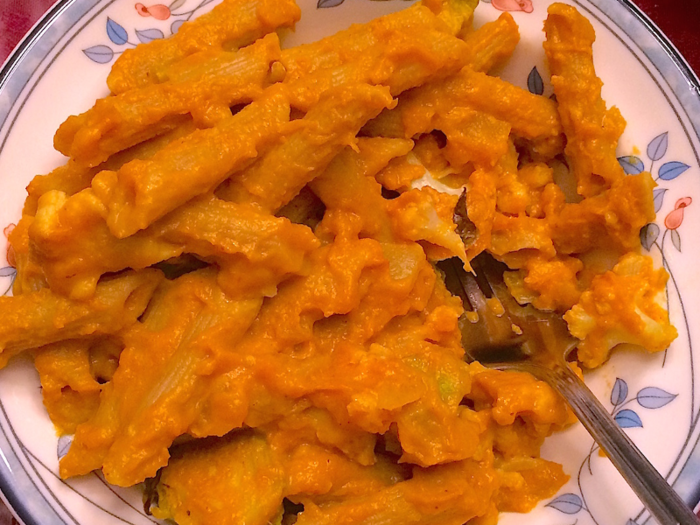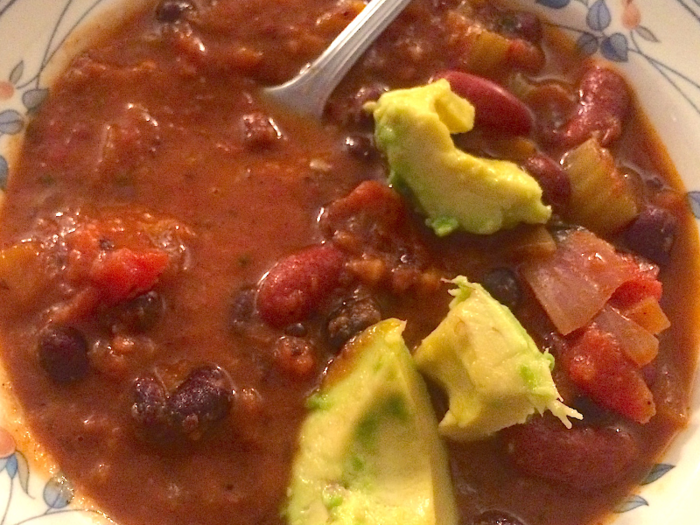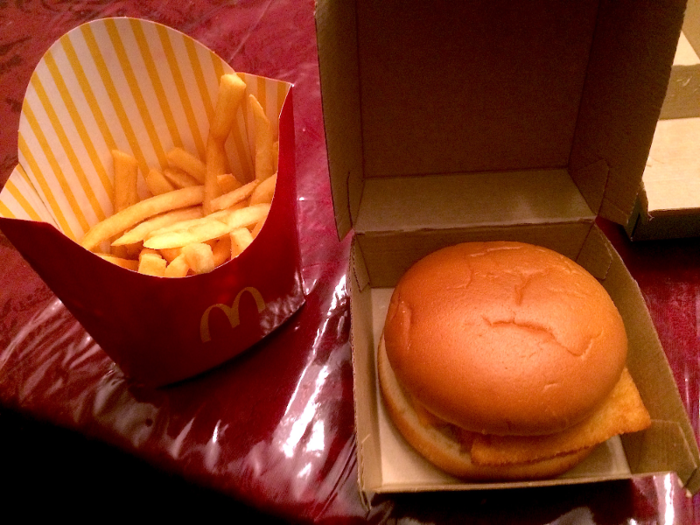I tried to follow an intense medieval fast for Lent - and realized it's much harder to do in the modern world
Before I embarked on the fast, I checked to see if it was okay to drink liquids throughout the day. I found an article on CatholicCulture.org that indicated beverages were fine, as long as they adhered to "the spirit of fasting." So giant smoothies packed with fruits and other toppings were out, but Cokes and Snapples from the office kitchen were fine.

I also asked my good friend who observes Ramadan every year for advice. She recommended trying vitamin-rich dates (which, I confess, I never got around to buying) and sticking to nutritionally-balanced evening meals (which I definitely stuck to, aside from two notable detours involving calamari and Filet-O-Fish).

I also asked Newman if she had any recommendations. She reminded me to not forget about the spiritual aspects of the fast: "If you are Catholic and you're doing this as a religious exercise, the idea is it's always accompanied by prayer. It's not something you would do just for its own sake."

I kicked off the fast on Ash Wednesday, which is an automatic day of fasting for Catholics. Since Ash Wednesday fell upon St. Valentine's Day this year, I also had to turn down sweets in the office.

When I got home, I ate some fish and French fries. I didn't feel hungry. The first day of my fast was off to a good start.

The next day, I felt pretty low energy in the morning. To perk up, I grabbed some English breakfast tea with milk at work. As I sipped it, I realized I'd already broken the fast by consuming dairy. Mea culpa.

I'm embarrassed to admit that I broke the fast a number of times when it came to taking tea with milk. I could've used almond milk instead, but almond milk is terrible and I have no self-control when it comes to tea.

As the days went by, I noticed that I was becoming more and more aware of food. Every day, we're bombarded with ads, videos, articles, and images of juicy, delicious chow. It's inescapable — and terrible to behold when you're trying to fast. I had to mute INSIDER Cheese on Facebook and avoid Instagram in general. Before long, even those bland Grand Central pretzels started to look enticing to me.

Temptations continued to pop up throughout the week. On Thursday, I hung out with two friends who I hadn't seen in a while. We met up at our usual bar, where I passed on the red wine and stuck to Coke.

Normally, I spring for the mozzarella sticks at this bar, but cheese was out for me this time around. After obsessing over a number of the menu's vegetarian options, I went for Lent-friendly calamari instead. I didn't get to snap a photo of the succulent seafood because I wolfed it down in two seconds. I was going to order onion rings too, but I still have some shame.

Medieval fasters didn't have to contend with that same food porn overload, or invitations to dimly-lit West Village bars. Newman said that in Christianity, organized fasting probably originated in fourth century monasteries, and then spread out to the larger population over time.

Source: Facebook
Your average medieval Christian would've been expected to skip meat for all of Lent, in order to commemorate the 40 days Jesus spent fasting in the desert. Fridays throughout the year were also meant to be meatless — a tradition which continued in the Catholic Church until the Second Vatican Council in the 1960s.

According to Newman, medieval peasants in many areas wouldn't necessarily have eaten a lot of meat anyway. "We don't have enough evidence to say how many people strictly kept the fast, but it was a kind of exercise in communal solidarity," Newman said. "Certainly you wouldn't want to eat meat in public, for example, because that would look very bad."

For me, the lack of meat wasn't a huge deal. I like an occasional burger, but red meat isn't really my thing. On Friday, I ate pumpkin, cheese-free baked pasta. The fast's constraints of eating one meal a day and the lack of dairy were what killed me, not the vegetarianism.

But some fasts were more strict than just abstaining from meat. Newman said medieval penitentials — books invented by sixth century Irish monks that listed sins and appropriate penances — could be pretty harsh. It's unlikely some of the recommendations, like fasting on bread and water for seven years, were widespread, but Newman said they did result in some corrupt situations where people bribed others to take on their penance (e.g. you might get your four friends together to each complete a week of your four week fast).

"Extraordinary" fasts like the Black Fast certainly weren't the norm, outside of the monastery walls. According to historian Caroline Bynum's book "Holy Feast and Holy Fast," that trend became more intense in the late medieval period, mostly among women in religious orders. Stories abounded about women who were said to "live for years eating nothing except the Eucharist," Newman said. One such woman was influential theologian and doctor of the Church St. Catherine of Siena.

Source: "Holy Feast and Holy Fast"
"She said that her fasting wasn't voluntary," Newman said. "She tried to eat but it hurt her stomach too much." Her confessor, Blessed Raymond of Capua, urged her to eat regularly, but her health continued to deteriorate and she died at the age of 33. Historians like Rudolph Bell have speculated that she had an eating disorder.

Source: "The Life of St. Catherine of Siena," "Holy Anorexia"
On Saturday, I had what you might call a full-fledged breakdown. I was hungry to the point of distraction. I couldn't overcome it by throwing myself into work, either. I ended up succumbing to the kitchen's siren song and making myself a bowl of clam chowder. I've never been so deliriously happy about canned soup before.

My downward spiral into gluttony continued when I was offered some wine to go with my dinner that evening. In my infinite weakness, I accepted it. I'd have been drummed out of most medieval convents, I suppose.

My willpower had definitely eroded through a combination of decision fatigue, hunger, and boredom. I did keep up certain aspects of the fast, however, and ate vegetarian chili that night.

On Sunday, I worked the weekend shift for Business Insider, and wrote an article about the strange, Catholic history of McDonald's Filet-O-Fish. I had the next day off, for President's Day. I decided that I wanted — no, needed — to have the fish sandwich, which I'd never tried before.

Source: Business Insider
So I made a McDonald's run and purchased two Filet-O-Fish sandwiches. They were great. One nice thing about intense fasting is that it really boosts your enjoyment of each meal. It's harder to take food for granted when you're not eating much of it on a daily basis.

I hit a bit of a wall on Tuesday and began to feel quite tired during the day. Dinner that night consisted of white bean soup.

I also supplemented that meal with a side dish of fruit. Was that cheating? Probably.

I also had more soup on Wednesday. It feels weird to point this out, since the purpose of the Black Fast is spiritual nourishment, but skipping lunch and breakfast during the week is also a nice boost for your bank account.

That impetus to save money went out the window pretty quickly, though. On Thursday, I began to feel very irritable and unfocused by around noon. I grabbed my wallet and coat and, almost in a trance-like state, rushed out of the building to the nearest Pret a Manger. I proceeded to purchase and eat a giant tuna sandwich, with decadent tomato soup. It was a lovely lunch, but I immediately felt bad about breaking my fast again.

On Friday, it finally came time to put an end to the Black Fast for good. I celebrated with wine and spinach pizza for dinner.

I've focused more on my failures and the food-related aspects of the Black Fast. But religious fasts aren't diets, and they're certainly not about getting around the rules. The hunger served as a nice reminder to pray more. For all my griping, I did find this fast to be a cleansing spiritual experience, and I'd consider trying it again.

Popular Right Now
Popular Keywords
Advertisement